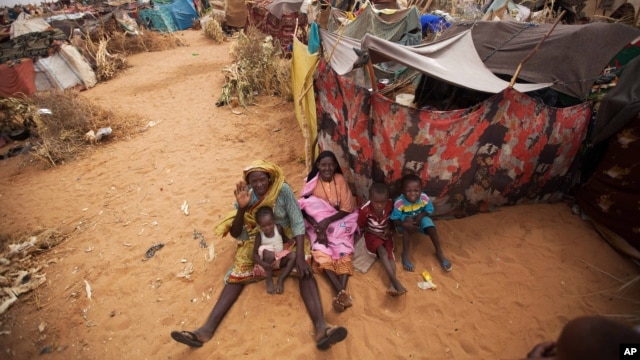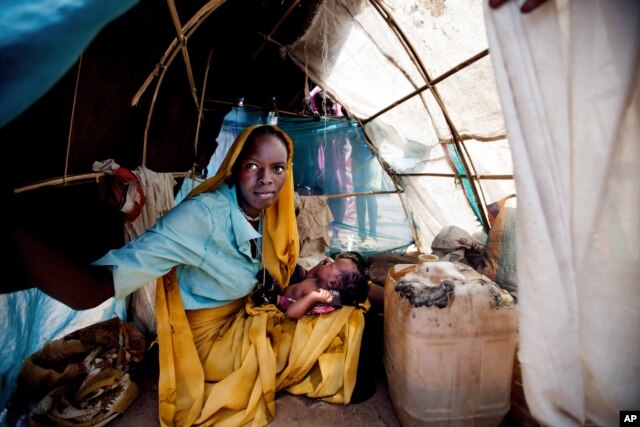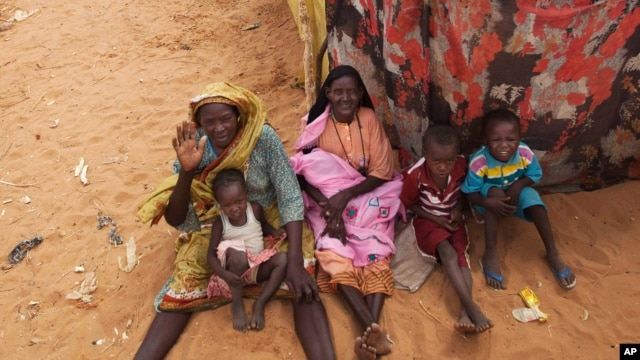
27.06.2014
Quỹ Nhi đồng Liên Hiệp Quốc
cho biết Sudan ngày nay đang là quê hương của một trong những cuộc khủng
hoảng cho trẻ em lớn nhất trên thế giới. UNICEF cảnh báo xung đột, thất
tán và kém phát triển đang khiến trẻ em có nguy cơ tử vong, bệnh tật và
khuyết tật.
Năm 2003, khi xung đột ở khu vực Darfur của Sudan đang ở trên bản đồ
truyền thông toàn cầu, hai triệu người đã bị thất tán. Hiện nay, 10 năm
sau, tình trạng ở khu vực bị xung đột ảnh hưởng đó vẫn chưa được cải
thiện đáng kể. Thế nhưng cuộc khủng hoảng không còn được đặt lên các
tiêu đề báo chí nữa.
Ðại diện ở Sudan của Quỹ nhi đồng Liên Hiệp Quốc Geert Cappelaere cho
biết 1,2 triệu người vẫn còn bị thất tán và 400.000 người khác bị thất
tán mỗi năm. Khoảng 65% những người bị thất tán trong nước là dưới 18
tuổi.
Ông cho biết nhiều em trong số này đã lớn lên trong những trại tạm cư
ở Darfur. Ông nói chúng đang trong tình trạng nguy hiểm bị trở thành
một thế hệ bỏ đi nếu chúng không thể thoát ra khỏi cuộc sống này.
Ông gọi tình trạng của hầu hết trẻ em là thảm khốc và nói trẻ em bị ảnh hưởng nghiêm trọng bởi một số cuộc xung đột trong nước.
Chính quyền Sudan và phe nổi dậy tiếp tục giao tranh ở Darfur. Nhưng,
không giống như 10 năm trước, ông Cappelaere nói các vụ xung đột trong
bộ tộc đang gia tăng:
“Dĩ nhiên, chúng tôi cũng vẫn có chiến tranh tiếp diễn ở các tiểu
bang miền nam Sudan, ở bang Kordofan, Blue Nile nơi chúng tôi ước tính
có 500.000 trẻ em mà chúng tôi không thể tiếp cận được trong ba năm qua.
Chúng tôi không thể tiếp cận bởi vì cuộc xung đột rất ác liệt đang diễn
ra giữa chính các lực lượng của chính quyền Sudan và SPLM phía bắc, lực
lượng Phong trào Tự do Nhân dân Sudan ở khu vực miền Bắc.”
Một người phụ nữ và một em bé trong chiếc lều trú ẩn tạm thời ở trại tỵ nạn Kalma, Darfur, Sudan
Ông Cappelaere cho biết trẻ em ở các tiểu bang này không được tiêm
chủng phòng chống các bệnh chết người trong nhiều năm và đang trong nhóm
nguy cơ rất cao bị nhiễm các bệnh này. Mặc dù Sudan đã miễn trừ bệnh
bại liệt kể từ năm 2011, nhưng ông cảnh báo căn bệnh gây tê liệt này có
thể xuất hiện lại. Ông cho biết các nhân viên cứu trợ đã không thể thực
hiện các chiến dịch tiêm chủng bại liệt trong ba năm ở các khu vực có
xung đột này.
Ông nói sự kém phát triển mãn tính ở Sudan đang gây phương hại nặng nề cho trẻ em trên khắp cả nước:
“800.000 trẻ em ngày nay bị suy dinh dưỡng trầm trọng ở Sudan. Ðiều
thú vị là đại đa số những trẻ em này không ở trong các khu vực bị xung
đột ảnh hưởng. Ða số trẻ em là ở miền đông đất nước nơi ít bị xung đột
trong thập niên qua. Do đó, nguyên nhân của suy dinh dưỡng không liên
quan đến xung đột. Nó liên quan nhiều hơn với việc thiếu đầu tư vào các
dịch vụ cơ bản. Một thực tế quan trọng, nhưng đáng buồn”.
Một thực tế đáng buồn khác, ông nói, là trẻ em đang bị tước đi quyền
được giáo dục. UNESCO cho biết 58 triệu trẻ em trên toàn cầu bị thất
học, hai triệu trong số đó đang sống tại Sudan.
UNICEF đã chi hơn một tỉ đô-la ở Darfur trong thập niên qua, nhưng cơ
quan này cũng đồng ý là kết quả từ việc đầu tư này không đáng kể. Hiện
tại, cơ quan này đang điều hành hơn 100 cơ sở ở khắp Sudan dựa trên một
ngân sách eo hẹp. Cơ quan này đã nhân được chưa đầy 30% trong số 140
triệu đô-la cần có để tiếp tục các chương trình cứu người trong năm nay.
UN: Millions of Sudan's Children Facing Acute Crisis
Photo
released by the United Nations African Union Mission in Darfur (UNAMID)
shows women and their children outside their tents at the Zam Zam
refugee camp for internally displaced people (IDP) in North Darfur,
Sudan, June 11, 2014.
June 27, 2014 12:36 PM
GENEVA —
The U.N. Children’s Fund said Sudan today is home to one of the biggest children’s crises in the world. UNICEF warns conflict, displacement, and underdevelopment are putting children at risk of death, disease and disability.
In 2003, when the conflict in Sudan’s Darfur region was on the global
media map, two million people were displaced. Now, 10 years later, the
situation in that conflict-stricken area has not substantially improved.
But the crisis no longer generates headlines.
Representative in Sudan for the U.N. Children’s Fund Geert Cappelaere
said 1.2 million people are still displaced and another 400,000 have
become newly displaced this year. About 65 percent of these internally
displaced people are under the age of 18.
He said many of these children have grown up in Darfur displacement
camps. He said they are in danger of becoming a lost generation if they
are unable to escape from this life.
He called the situation of most of the children dire and says
children are seriously affected by a number of conflicts in the country.
The government of Sudan and rebel factions continue to fight in
Darfur. But, unlike 10 years ago, he said inter-tribal clashes are
growing.
“Of course, we have also still the war going on in the southern
states of Sudan - in Kordofan states, Blue Nile where we have an
estimated 500,000 kids we have not been able to access for the last
three years. We have not been able to access because a very active
conflict going on between the government of Sudan’s forces and the SPLM
north, Sudan Peoples’ Liberation Movement army in the northern sector,”
said Cappelaere.
Cappelaere said the children in these states have not been vaccinated
against killer diseases for years and are at high risk. Though Sudan
has been polio free since 2011, he warns this crippling disease could
resurface. He said aid workers have been unable to mount polio
immunization campaigns for three years in these areas of conflict.
He said chronic underdevelopment in Sudan is hitting children hard throughout the country.
“800,000 children today are acutely malnourished in Sudan. What is
interesting is that a majority of these children are not in the
conflict-affected areas. A majority of these children are in the east of
the country that has been spared of much conflict over the last
decade," Cappelaere noted. "So, the reason for that malnutrition is not
conflict related. It has much more to do with an under-investment in
basic services. An important, but sad reality.”
Another sad reality, he said, is that children are being deprived of
education. UNESCO reports 58 million children globally are out of
school, two million of them are living in Sudan.
UNICEF has spent more than $1 billion in Darfur over the past decade,
but it agrees the returns from this investment are paltry. Currently,
it runs more than 100 operations throughout Sudan on a shoestring
budget. The agency has received less than 30 percent of the $140
million it needs to continue its life-saving programs this year.


No comments:
Post a Comment